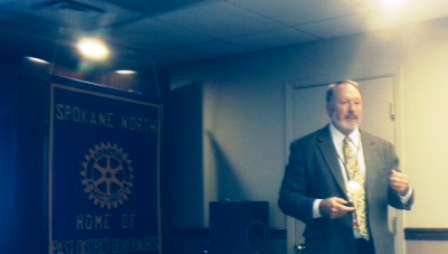Mead Supt. Tom Rockefeller - Bond and Levy
Posted by Charles Rehberg
on Dec 22, 2014
Spokane North Notes
A weekly bulletin of the Spokane-North Rotary Club
December 22, 2014
Editors: Chuck Rehberg and Sandy Fink
Program coordinator and photo: Jim Minkler
Happy Holidays!!
No meeting: The club, by tradition, does not meet between Christmas and New Year’s. See you all Monday, Jan. 5, at the Lincoln Center. Have a blessed, meaningful holiday season.
Mead superintendent spells out his gift list
Remember, class, “B” is for “building” (as in bonds) and “L” is for “learning” (as in levies).
The Mead School District, and several others in Spokane County, will ask voters to fund their “B’s” and “’L’s” on ballots due Feb. 10.
 Mead Supt. Tom Rockefeller did the math and made his case at the club’s Dec. 22 luncheon. If Santa is kind, Mead will have voter support of at least “50 percent plus one” for the levy and a 60 percent “super-majority” for its bond proposal.
Mead Supt. Tom Rockefeller did the math and made his case at the club’s Dec. 22 luncheon. If Santa is kind, Mead will have voter support of at least “50 percent plus one” for the levy and a 60 percent “super-majority” for its bond proposal. “I’m speaking for all the school districts in the Spokane area (asking for funding support),” Rockefeller said. “We have great school districts here.”
The Mead levy rate would remain the same, $4.21 per thousand of assessed valuation. The levy provides 23 percent of the district operating budget, he said.
The proposed bond rate of $1.42 per thousand would fund a menu of improvements, mainly modernizing Shiloh Hills and Midway elementary schools, both 34 years old, and replacing Northwood Middle School, a 56-year-old building. Bond passage funds 68 percent of capital costs and triggers a state match of 32 percent, Rockefeller said. He added, “The state wants schools rebuilt or modernized after 30 years.”
Another bond issue is added school security, “including controlling access through one door,” Rockefeller said.
Mead has 9,802 students, -- up 200 since September – in its two high schools, two middle schools and eight elementaries, plus some specialty schools (including academy, charter, alternative, “parent-partner (for home-schooled students) and “the state’s first STEM school.” Annual operating budget is $95 million.
“We have a 92 percent on-time high school graduation rate and 95 percent extended (for students who miss and make up one or two classes), Rockefeller said, adding that the state average is 75 percent. “There are some schools in the Puget Sound which have trouble hitting 60 percent,” he said.
The superintendent also dispelled some myths.
“In Mead, some people think we are rolling in money,” Rockefeller said. “But of the 295 school districts in Washington, Mead is funded at 273rd. Part of that is because we don’t get a lot of federal or state funds for students with special needs.” He added that Mead’s levy tax rate, at $1.42 per thousand, is much lower than District 81, at $1.96, and Central Valley, at $1.81.
He also added that his district, like all districts, must deal with court-ordered, but unfunded mandates, such as full-time supervision for students deemed sexual predators. “The courts say we have to educate them,” he said.
Another myth is perceived lack of diversity in the district. “We have 24 different languages spoken in the district, including Marshallese Island, Russian and Slavic,” Rockefeller said.
Mead shares several other challenges, including conforming the curriculum to “Common Core Standards,” implementing Next Generation Science programs, and waiting for “the other shoes” to drop with the class-size funding challenges of full-day kindergartens and Initiative 1351 and the State Supreme Court’s McCleary Decision on education reform. If fully implemented, Mead would need to build at least 45 new classrooms, Rockefeller said.
The superintendent referenced recent news coverage of Five Mile Prairie residents complaining that the new elementary there, even though it accommodates 650 students, is “not big enough” and some students must be bused to other schools.
“If we followed that reasoning (that rapid-growth areas still must house all students in the neighborhood), we’d have elementaries with 4,000 to 5,000 students.”
A big challenge for the levy and bond measures, Rockefeller said, is getting younger voters to register and to vote. “Turnout is really low – just 23 percent – of voters under age 35,” he said.
